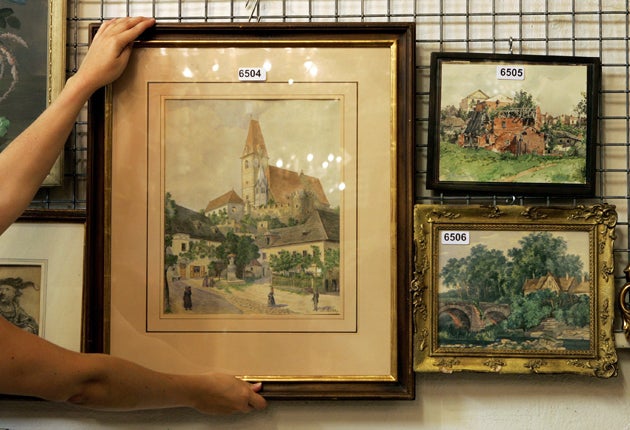Hitler's art of self-delusion
A forthcoming auction will put the Führer's claims of artistic greatness to the test, reports Tony Paterson

As a German auction house prepares to sell off three of Adolf Hitler's watercolours, new evidence has emerged suggesting that the Nazi leader remained convinced he was an artistic genius and was often irritatingly obsessed by art despite his failure as a painter.
The three paintings are kitsch displays of cottages, mills and churches nestling in rural landscapes, which were painted in 1910 and 1911 in Vienna. At the time Hitler was struggling to begin a career as an artist and developing many of his anti-Semitic theories.
The works will be put up for sale by a Nuremberg auction house next month and are expected to fetch more than €15,000 (£13,000) apiece. Experts on Hitler's paintings rate one of the watercolours, entitled White Church in the Wachau, as one of his chief works.
Herbert Weidler, the head of the auction house, said the paintings were part of a collection belonging to an Austrian-Jewish family that collected works by young Vienna artists at the turn of the last century.
"The people who will buy these paintings are academics and businessmen," said Mr Weidler, whose auction house sold another two of Hitler's estimated 723 paintings last month. "The sales do not attract people with bovver boots and skinhead haircuts."
The paintings help to explain why Hitler never made it as an artist and his attempts to enroll at Vienna's academy of fine arts were twice turned down flat. However, new research conducted by an Austrian art historian concludes that, despite his rejection, Hitler remained obsessed by art for most of his life, convinced he was an artistic genius removed from ordinary moral values.
In her book Genius Delusions: Hitler and Art, Birgit Schwarz claims the Nazi leader remained convinced of his extraordinary talent until he committed suicide in his Berlin bunker in 1945.
"The extent to which Hitler considered himself an artistic genius has been, underestimated," Ms Schwarz said in an interview with Der Spiegel magazine. "Many of his actions were driven by this self-perception and his overheated artist's ego. His love of art led to the heart of evil."
Ms Schwarz illustrates Hitler's obsession with art by citing the Italian art historian Ranuncio Bandinelli, who was given the job of escorting the Nazi leader on a tour of art galleries during his official visit to Italy in 1938.
Mr Bandinelli recalled in his journal that Hitler spent hours upon end admiring the paintings to the point that his Italian host, the Fascist dictator Benito Mussolini, was conspicuously irritated.
Hitler's rejection by art school increased rather than diminished his self perception as a genius, Ms Schwarz insists, even if he considered himself an unrecognised one. She said that he collected works by lesser-known artists as a result.
However she argues that, after his rejection, he began to think that his genius could best be expressed in architecture rather than painting.
Hitler went to Munich after Vienna, and, according to Ms Schwarz, his new-found obsession with architecture is evinced by plans he drew at the time for a competition to design a new opera house for Berlin. Hitler never submitted an entry, but, Ms Schwarz maintains: "He thought he could rank equal with the most famous architects of the time."
Join our commenting forum
Join thought-provoking conversations, follow other Independent readers and see their replies
Comments